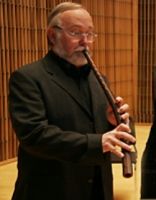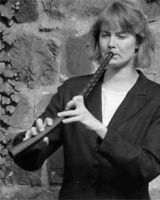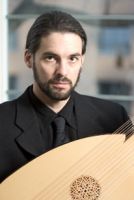Cornettos Charm Catacoustic Consort Audience
Mary Ellyn Hutton
Posted: Dec 22, 2009 - 10:27:18 PM in
reviews_2009

Bruce Dickey
|
You know that special present you wait to open on your birthday or Christmas?
That is how I felt about the Catacoustic Consort's Christmas concert December 19 at North Presbyterian Church in Northside.
Everything -- the setting, the sound, the people as enchanted as I was, but most of all, the music -- made it a great way to end the 2009 performance year in Cincinnati..

Kiri Tollaksen
|

Daniel Swenberg
|
Guest artists were Bruce Dickey of Bologna, Italy, today's leading exponent of the cornetto, Kiri Tollaksen, a splendid cornettist from Ann Arbor, and Daniel Swenberg of Highland Park, New Jersey, toting a six-foot theorbo (bass lute).
(The early music community is a relatively small one, so practitioners must often travel to perform concerts together.)

Annalisa Pappano with bass viola da gamba
|
Joining them in music from 17th-century Italy was Catacoustic Consort artistic director Annalisa Pappano on bass viola da gamba.
First of all, what is a cornetto? Dickey, a scholar/cornettist who studied at Indiana University and Schola Cantorum Basiliensis in Basel, Switzerland, answered that right away. Long consigned to history, the cornetto was an extremely popular instrument about 1500 to 1750. It was gradually replaced by the violin during the 17th and 18th centuries.
The cornetto looks like a bent recorder. It is made of hardwood covered with leather and has finger holes like a woodwind instrument. It has a trumpet-shaped mouthpiece made of animal horn. It sounds like a trumpet and is considered a member of the brass family. It is extremely difficult to play, requiring the skills of both families of instruments and the ability to blend them successfully in creating the cornetto's distinctive, almost vocal sound.
The cornetto (or cornett) is nimble and can "sing" and get around like the human voice. It comes in several sizes, from treble to bass. The tenor cornetto is shaped like an "S." The bass is also called a serpent and therein lies a tale, said Dickey.
With its trumpet-like sonority, the cornetto was often associated with apocalyptic events like the Last Judgment. It can be seen in art works played by demons as well as angels. It is usually covered with black leather and bears scaly, serpent-like carvings. (Some, said Dickey, may even have a serpent's head attached to the bottom.)
This forgotten instrument was revived due to the efforts of Dickey and others, including his ensemble Concerto Palatino, during the re-emergence of early music from the 1950s onward. Hearing it is magical. You may feel like your eyes or your ears are deceiving you. But there it is, sounding like a "delicately played" trumpet" (Dickey), a wind instrument, "perhaps a flute," and a light, male soprano.
The ensemble performed in the chancel of North Presbyterian Church, framed by a floor-to-ceiling Gothic arch where the pipe organ resides. The program, entitled "A Christmas Fanfare," consisted of composers from the time of Claudio Monteverdi (died 1643), including Girolamo Frescobaldi, Giuseppe Scarani, Giovanni Paolo Cima, Battista Bovicelli, Lodovico da Viadana, Niccolo Corradini, Philipp Friedrich Buchner (the lone German in the group), Giovanni Martino Cesare and a pair of cloistered nuns, Sulpitia Lodovica Cesis and Chiara Margarita Cozzolani.
The church was decked out in Christmas greens. An Advent wreath covered with poinsettias hung to the right of the chancel steps. There was a Christmas tree against the back wall. With the music, it created a serene, almost sensual impression. (Interestingly, the sculptor Benvenuto Cellini loved to play the cornetto, which his disapproving father referred to as "quel lascivissimo cornetto," "that lascivious cornetto").
The motet "Christus resurgens" and a sonata by Scarani made a remarkable impression early on, with their virtuosic demands on the cornetto. A pair of motets by Sulpitia Cesis and Chiara Cozzolani ("Angelus ad pastores" and "Quis audivit") provided an insight into the cloister, which often had nothing to do with religion but provided a convenient place for families to put their daughters for one reason or another (like having to pay dowries for them to marry). Many of these women were from wealthy and/or noble families and continued their intellectual and artistic pursuits behind convent walls. Cozzolani was particularly famous, both as a composer and for her opposition to the hierarchy, which sought to limit the activities of cloistered nuns, even musical ones. Her "Quis audivit" penned in 1696 was the newest work on the program.
Tollaksen performed both pieces on the "mute" cornetto, an instrument with a mellower voice than other members of the cornetto family, having a straight barrel with a mouthpiece carved into it. Accompanied by Pappano and Swenberg, she produced a caressing, cajoling sound that was quite engaging.
Cornettists, Dickey explained, were great improvisers. He demonstrated this by having Swenberg play a famous madrigal, "Ancor che col partire," followed by the full ensemble on Bovicelli's "Angelus ad pastores," a set of "divisions" (embellishments) on the madrigal set to a Christmas text. The original madrigal by Cipriano de Rore, played to subtle, plangent effect by Swenberg, was highly appropriate for such treatment, Dickey said, because it is a love song about parting and returning. Returning is so sweet, the poet sings, that he would like to part and return 1,000 times,
Another highlight was a pair of "Canzoni in risposta" ("risposta" means "reply") by Viadana and Corradini. The so-called echo works were performed by Dickey standing behind the choir stall on the left and Tollaksen on the right, with Swenberg and Pappano in the middle. The quasi-antiphonal effect made a festive impression.
Violist Pappano and Swenberg offered a fine performance of Frescobaldi's lively, imitative "Canzona Quinta detta la Tromboncina." The final set, for all four musicians, comprised two motets by Cesare, a cornettist who worked at the ducal court in Munich. "Sancta Maria" was light and delicate. By contrast, "La Goia" ("Joy") was animated and energizing, a well-chosen finale with its rapid chromatic lines. Listeners gathered around the artists afterward with greetings of the season and to ask questions about their unusual instruments, a regular feature of Catacoustic programs.
Catacoustic Consort's next concert is 7:30 p.m. February 6 at North Presbyterian Church and 3 p.m. February 7 at St. Gabriel Catholic Church in Glendale, and will feature the baroque oboe. For information, visit www.catacoustic.com




